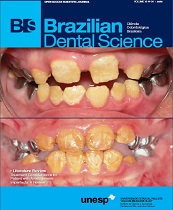Masticatory muscle activity evaluation by electromyography in removable partial denture users
DOI:
https://doi.org/10.14295/bds.2013.v16i4.917Resumo
Objectives: The aim of this study was to evaluateby electromyography the activity of the temporalisand masseter muscles in removable partial dentures(RPDs) users, before and after new RPDs installation.Material and Methods: Ten patients were selectedfor this study. All subjects were edentulous in theposterior mandibular region (Kennedy class I orII), fully dentate in the antagonist arch, and dentalprosthesis users, which needed to be replaced. Theelectromyographic activity (EMG) recorded thesuperficial masseter and temporalis muscles, duringthe maximum voluntary bite force and the restposition. Maximum mouth opening was also verified.The measurements were recorded at four specifictimes: using the old prosthesis (T0), right after thenew prosthesis installation (T1), two weeks (T2) andfour weeks (T4) after installing the new prosthesis.All the RPDs were made by an experienced dentistand the same laboratory. Data were statisticallyanalyzed by ANOVA and Tukey tests (? = 0.05).Results: EMG values had high standard deviation atthe time T0. Generally, the mean values decreasedafter new prosthesis installation, especially aftertwo weeks from the installation (T2). During therest position, the left masseter and left temporalismuscles showed statistically significant gradualdecrease in their activities over time. Conclusion:New prostheses have positive effect on the patient’smuscular activity. However, an adaptation period ofthe muscle fibers to the new prosthesis is needed.
Keywords
Electromyographic activity; Dental occlusion; Masseter; Removable partial dentures; Temporalis.
Downloads
Downloads
Arquivos adicionais
Publicado
Como Citar
Edição
Seção
Licença
TRANSFERÊNCIA DE DIREITOS AUTORAIS E DECLARAÇÃO DE RESPONSABILIDADE
Toda a propriedade de direitos autorais do artigo "____________________________________________________________________" é transferido do autor(es) para a CIÊNCIA ODONTOLÓGICA BRASILEIRA, no caso do trabalho ser publicado. O artigo não foi publicado em outro lugar e não foi submetido simultaneamente para publicação em outra revista.
Vimos por meio deste, atestar que trabalho é original e não apresenta dados manipulados, fraude ou plágio. Fizemos contribuição científica significativa para o estudo e estamos cientes dos dados apresentados e de acordo com a versão final do artigo. Assumimos total responsabilidade pelos aspectos éticos do estudo.
Este texto deve ser impresso e assinado por todos os autores. A versão digitalizada deverá ser apresentada como arquivo suplementar durante o processo de submissão.




























